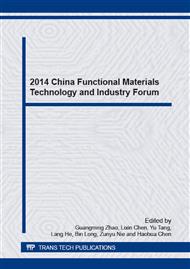p.800
p.807
p.815
p.822
p.831
p.837
p.842
p.846
p.855
Synthesis and Properties of Carbon and Yttrium Co-Doped TiO2 Photocatalyst
Abstract:
TiO2 photocatalysts doped with different element of C and Y were synthesized by sol-gel process using glucose, yttrium nitrate and tetrabuty ltitanate as precursors. Samples characterized by XRD, XPS, TEM, PL and UV-Vis methods. The photocatalytic activity of samples was investigated by photocatalytic degradation of methylene-blue (MB) under the irradiation of fluorescent lamp. The results indicate that C ion and Y ion are incorporated into the lattice of TiO2, and C doping accelerate phase transition from anatase to rutile phase, but Y doping inhabits the phase transition. It was also found that both C and Y doping can broaden the absorption spectrum to visible light region and inhibit the recombination of the photo-generated electron and hole pairs. The synergy effect of co-doped C and Y ions provides C-Y-TiO2 sample better photocatalytic activity than that of the single-doped samples and P25 under fluorescent lamp. The photocatalytic activity of the sample with C, Y co-doped is the best under the irradiation of fluorescent light. It is 94.23% within 3 hours and significantly higher than that of Degussa P25 (44.72%) under the same experimental conditions.
Info:
Periodical:
Pages:
831-836
Citation:
Online since:
December 2014
Authors:
Keywords:
Price:
Сopyright:
© 2015 Trans Tech Publications Ltd. All Rights Reserved
Share:
Citation:


